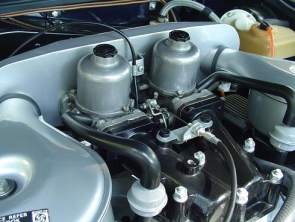|
387
Topping
up the carburettor damper on an SU HIF
Victor Smith (Harvest Gold 1089) describes a simple routine
service item which makes the MGBGTV8 a smooth and pleasant
drive. (Oct
08)

Topping
up the dampers on the twin SU HIF carburettors on an MGBGTV8
is a very worthwhile simple service routine which can make
driving the MGBGTV8 so much more enjoyable with a smoother
pick up and acceleration and a less frisky engine at slow
speeds. Enthusiasts not familiar with SU carburettors may
not be aware of the benefits of regular damper topping-up
or what to do, so this note is a straightforward guide.
Unscrew the black plastic cap at the top of each carburettor
suction chamber and gently lift the piston and damper
up to the top of their travel. Do not attempt to pull
it right out. Fill the circular opening at the top of the
suction chamber with engine oil (preferably 20-50 multigrade)
until the oil level is just visible where there is a slight
change in the internal diameter of the tube
(marked above).
Carefully push the damper down until the black cap contacts
the top of the suction chamber. You may need to repeat the
process to achieve the oil level noted above and then screw
the black cap on firmly on the suction chamber.
The use of "gently" above is a caution when lifting
the piston damper because care must be taken not to dislodge
the damper retaining clip which is pressed into the top of
the piston rod. So just lift the black cap very carefully
and park it whilst you add oil.

A traditional small engineer's oil can with a moderately long
flexible spout and convenient lever actuating a pump mounted
in the handle is the ideal piece of equipment for leaning
across from the wing and directing a gentle flow of oil into
the damper. The pumping action on that type of oil can provides
the ideal level of control for this operation.
This procedure is set out on page 58 of the MGBGTV8 Driver's
Handbook AKD8423. More
|

|
What
is the function of the damper?
The basic function of the carburettor dashpot is to
lift the large diameter piston in the bell shaped suction
chamber for a given pressure differential across the
upper and lower faces of the piston. Underneath the
piston is the airstream from the aircleaners through
the butterfly valve and on to the engine. The underside
of the piston is connected to a tapered needle extending
down into the jet below which governs an accurate supply
of fuel into that airstream. That fuel mixes with air
and passes through the butterfly valve and on to the
engine.
Above the piston in the dashpot assembly there is also
a guide rod and piston damper. The function of the guide
rod is to guide the piston accurately within the bore
of the suction chamber. The damper damps or moderates
the movements of the piston in the suction chamber and
consequently the changes in fuel supply governed by
the needle in the jet.
The
function of the damper is twofold: first it prevents
the piston from following the fluctuations of the air
flow at low engine speeds thereby keeping the piston
steady and second, when the throttle is opened rapidly,
it prevents the piston from rising rapidly in unison
with the throttle opening. When the piston rises rapidly,
the fuel/air mixture becomes weak because the air has
less inertia than petrol. By damping the movement of
the piston when the throttle is opened rapidly , the
piston movement is retarded to cause a momentary enrichment
of the fuel/air mixture which gives the engine a prompt
pickup.
The damper operates in a column of oil. Failure to maintain
an adequate oil level in the damper will cause carburettor
piston flutter and adversely affect pickup and acceleration.
So there is a need to top up the carburettor dampers
regularly using the simple service routine described
in this note.
|
Useful
reference
Tuning SU Carburettors
including full needle charts
Published by Speedsport Motobooks
ISBN 85113-072-0 |



